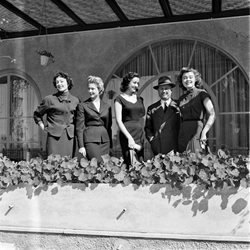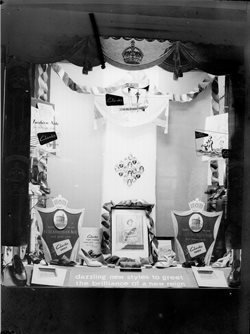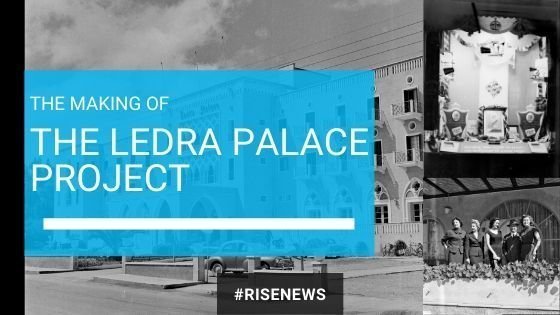One of my favorite things was visiting the Ledra Palace Hotel to create the 360 VR experience. We spent a couple of days filming with our team and had a very helpful young female UN soldier as a guide. Rosie took us around and talked to us about the hotel and their lives there.


Photos by Felix Yiaxis, Press and Information Office, photos taken in 1954.
In their majority, museums and cultural heritage sites established in Cyprus, with their practices and main narratives, usually reinforce either Greek Cypriot or Turkish Cypriot ethnonational identities. Therefore, they perpetuate the building up of cultural boundaries instead of facilitating peace building, in an island which is divided for more than 40 years despite its small size and its limited natural and financial resources. This project will try to distance from this notion and adopt a different, and more inclusive stand. This project is mostly based on the notion that museums dealing with difficult heritage can use technology to facilitate participatory and collaborative approaches, and actively engage different groups and communities (especially excluded, marginalized or silenced ones) in order to tell contested histories. Deep interest lies in the co-creation of content and narratives that influence collection and archiving practices.
All these could help bring out stories of people from various backgrounds who experienced the Ledra Palace Hotel with one way or another: as guests, as audience in a concert or a show, as participants in conferences, business or work meetings or as employees. The stories of employees that worked in the lower ranks of the hotel, of Turkish Cypriots who had some experience of the place, or even women who participated in fashion shows, charity events or art exhibitions are usually neglected for the sake of the political, diplomatic or military history of the place. These voices need to be heard and since this is not possible through the traditional way, the project will try to achieve it with the use of emerging technologies.


Photos by Felix Yiaxis, Press and Information Office
How do they do it?
Research and collection of information about the history of the Ledra Palace hotel is undertaken in three levels:
Firstly, interviews and crowdsourcing (oral history): The team conducted many interviews from people who experienced the hotel one way or another: as guests, employees or shareholders. A Facebook group called “The Ledra Palace Project” was also set up to help to encourage people to share their stories and photos of the hotel.
_______________________________________________________________________________________
For me, to be given permission to go inside the hotel was overwhelming. It’s one thing to read about a place, form a picture in your head and another thing to actually see it. It was also depressing that the current look of the hotel’s interior had nothing to do with what we had seen in old pictures.
I could think of several interesting things I learned during the interviews actually, but one that comes to my mind now is when I interviewed a couple who got married at the hotel on July 14, 1974. It was the last wedding reception taking place at the Ledra Palace. The couple stayed overnight and when they woke up the coup d état against Makarios had taken place so they had to rush out of the hotel. They actually had to leave secretly since the hotel closed its doors. Their shock was so big that some of their wedding presents remained unopened for some time and for years the couple did not celebrate their wedding anniversary. For me, their memory of Ledra Palace becomes a vehicle to talk about the unfortunate events of July 15 1974.
Another interesting interview I had, it was with a Ledra Palace barber: He told me that he gave Michael Kkashialos a haircut, who offered to pay him with a painting because he could not afford the haircut! The barber had many interesting stories of clients.
There are many interesting stories, sad or happy…
– Antigone Heraclidou, PhD (RISE Research Associate)
_______________________________________________________________________________________
Other primary sources of information include unpublished documents, newspapers photographs, objects, etc. Secondary sources include Published literature. The fact that the Ledra Palace is now used as barracks and located in the buffer zone is a huge challenge to the project. It is not simply trying to revive an out-of-operation hotel, but a hotel that was caught in the heart of the Cyprus conflict and is not easily accessible anymore.
A lot of creative brainstorming took place because of the project. All this exchange of ideas is helpful to the final goal, the staging of the Ledra Palace exhibition that will eventually take place at the Leventis Municipal Museum. The fact that the Leventis museum staff, historians, museum studies researchers and ICT researchers are working together for this project underlines its interdisciplinarity and versatility. Beyond RISE, the project found an appeal in the society on various levels. People from various backgrounds shared their thoughts and stories with us. The Ledra Palace project was endorsed by Greek-Cypriots, Turkish Cypriots, Armenians, British, UN officials and UNFICYP soldiers.


Another favorite event was the Buffer Fringe Festival. Two RISE teams – ITICA and the Museum Lab – collaborated together to create VR experiences and a holography table. The team that worked on the Buffer Fringe Festival consisted of: Kleanthis Neocleous, Savvas Avraam, Fotos Frangoudes, Panayiotes Kyriacou, Antigone Heraclidou, Maria Shehade, Myrto Aristidou and Iris Nibbering. We would like to thank them for the collaboration and truly fun and rewarding experience.
– Theopisti Stylianou-Lambert, PhD. (RISE Museum Lab MRG leader)
Ledra Palace becomes a vehicle through which, on the one hand, a cosmopolitan and artistic Nicosia of the past is celebrated, and on the other hand, the turbulent contemporary history of an island that is still divided in two is told. Effectively, it is a point of reference for many people, old and young, of diverse backgrounds. As such, the project can help foster mutual understanding between the two communities as well as contribute to social cohesion.
The project is endorsed by the Leventis Municipal Museum which is going to host the exhibition and, with the aid of the A.G. Leventis Foundation, take over the publication of the exhibition book.

